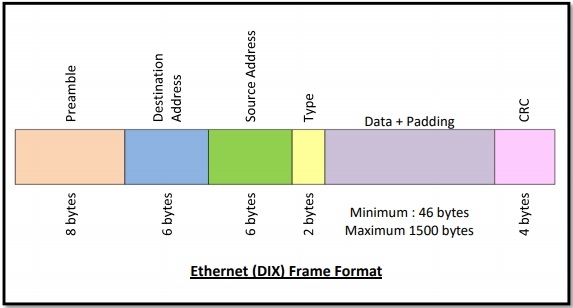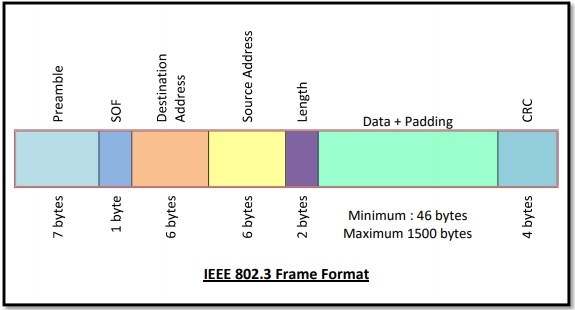
 Data Structure
Data Structure Networking
Networking RDBMS
RDBMS Operating System
Operating System Java
Java MS Excel
MS Excel iOS
iOS HTML
HTML CSS
CSS Android
Android Python
Python C Programming
C Programming C++
C++ C#
C# MongoDB
MongoDB MySQL
MySQL Javascript
Javascript PHP
PHP
- Selected Reading
- UPSC IAS Exams Notes
- Developer's Best Practices
- Questions and Answers
- Effective Resume Writing
- HR Interview Questions
- Computer Glossary
- Who is Who
What is Classic Ethernet MAC Sublayer Protocol?
Classic Ethernet is the original form of Ethernet used primarily in LANs. It provides data rates between 3 to 10 Mbps.It operates both in the physical layer and in the MAC sublayer of the OSI model. In the physical layer, the features of the cables and networks are considered. In MAC sublayer, the frame formats for the Ethernet data frame are laid down.
Classic Ethernet was first standardized in 1980s as IEEE 802.3 standard.
Frame Format of Classic Ethernet
Classic Ethernet frames can be either of Ethernet (DIX) or of IEEE 802.3 standard. The frames of the two standards are very similar except for one field. The main fields of a frame of classic Ethernet are −
Preamble − It is the starting field that provides alert and timing pulse for transmission. In case of Ethernet (DIX) it is an 8 byte field and in case of IEEE 802.3 it is of 7 bytes.
Start of Frame Delimiter (SOF) − It is a 1 byte field in an IEEE 802.3 frame that contains an alternating pattern of ones and zeros ending with two ones.
Destination Address − It is a 6 byte field containing physical address of destination stations.
Source Address − It is a 6 byte field containing the physical address of the sending station.
Type/Length − This is a 2 byte field. In case of Ethernet (DIX), the field is type that instructs the receiver which process to give the frame to. In case of IEEE 802.3, the field is length that stores the number of bytes in the data field.
Data − This is a variable sized field carries the data from the upper layers. The maximum size of data field is 1500 bytes.
Padding − This is added to the data to bring its length to the minimum requirement of 46 bytes.
CRC − CRC stands for cyclic redundancy check. It contains the error detection information.



